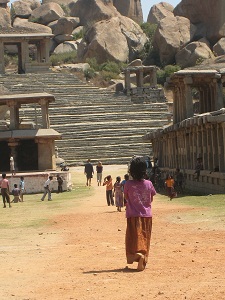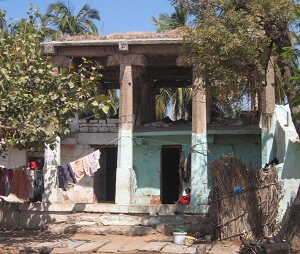You all remember this image from the movie E.T., right? E.T. is hiding amongst Drew Barrymore’s dolls, trying to blend in. Steve and I have been experiencing many moments on this trip that we’ve named “E.T. moments.” The kind of moments that remind us of “Home….home….” with outstretched glowing fingers, dusty voices, and feelings of familiarity that surprise us when we’re 13h45m from our home time zone.
The city of Kathmandu, in the stunning Kathmandu valley (hence the blog title), has been a remarkable change from the feelings, smells, colours, and pace we found during our three weeks in India. It’s a welcome change – even the temp difference which forces us to exchange the thin layers of shorts and tees in exchange for long johns, gloves, and space heaters – that has struck me as being more familiar than other places we’ve been. The world is huge, we’ve proven that over the last 2 months, but there are similarities that stretch from one side of it to the other. Especially, I’ve found, in the bustling city of Kathmandu…
For starters, the colour of the sky as a result of the weather. At first, I couldn’t quite place the feeling of leave-less trees and murky sky that we flew into two days ago. The brown and brick-coloured buildings with their intricate wood carvings took on a more solid and frosty appearance than anything we’d experienced. The weather was on the verge of allowing one to see her breath as we walked through the Garden of Dreams, a mid-city garden mecca located amidst the narrow alleyways and temples. The neo-classical architecture dates back to the 1920s, commissioned by a Nepalese field marshal partial to the Edwardian style and in need of a respite in the city. Now visitors can fork up 130 rupees (slightly less than US$2.00) to stroll through the private garden or have high tea on the veranda. As a first stop in Kathmandu, this was a puzzling one – but not because of the European-influenced garden (which is kinda familiar), but because of the manner in which the dormant flora reflected the sky. I finally pinpointed the feeling: it was the silent moment in New England right before the first big snow, after the leaves have fallen off the trees. We’ve been told there are 6 seasons in Nepal, I have yet to identify the unfamiliar outstanding two (does anyone know?), but having reached the end of their wintertime, I feel at home in a way that I can only recall while strolling in winter coats along Massachusetts Avenue in Boston, or crunching over recently-frosted undergrowth in the east coast woods (much like our time at Shana and Bryan’s wedding in Poughkeepsie).
In addition to the weather, which has followed us around the city, just before leaving the Garden of Dreams, we also stumbled upon a plaque with a quotation from one of my Zaydie’s favourite books of poetry by Edward Fitzgerald, the Rubaiyat of Omar Khayyam. So nice to have a little reminder of him, while at the same time a reminder of home and sitting across many-a-tables hearing him recite poetry.
 Another familiar aspect of this city is the people. Unlike our experience of being both the observer and the observed in India, which lasted the entire 3 weeks, the Nepalese folk we’ve found in Kathmandu have had more of a tendency to continue doing their thing with only quick glances in our direction. Perhaps I’m feeling the sense of familiarity because our experience in India was like no other and but moreso because there is an obvious efficiency in their work ethic that just continue despite the pale people wandering by that is reminiscent of some of my Western experiences. From the vendors who approach us with mandala necklaces and mini chess boards to the receptionist at our hotel, there is an outward gentility toward others that gives me a real feeling of respect and willingness to help, but also leaving me with no doubt that they’ll get it done. A salesman saw us looking at his yak wool blankets and asked if we would like to have a closer look inside his store – Steve and I, ever-prepped for a bargaining game and not in the market to make a purchase at that point, quickly shouted, “No thanks!” The man sensed our apprehension and said, “Not to worry, looking is free, take your time” and backed away. This could have been his sales pitch (that certainly worked), but we later experienced a similar “okay, not to worry” attitude coming from the vendors. This feeling of being allowed the time and space to look at something is certainly more familiar than some of the expert salespeople we’ve encountered in Thailand, Bali, and India. And we’ve many tchotchkes to prove it.
Another familiar aspect of this city is the people. Unlike our experience of being both the observer and the observed in India, which lasted the entire 3 weeks, the Nepalese folk we’ve found in Kathmandu have had more of a tendency to continue doing their thing with only quick glances in our direction. Perhaps I’m feeling the sense of familiarity because our experience in India was like no other and but moreso because there is an obvious efficiency in their work ethic that just continue despite the pale people wandering by that is reminiscent of some of my Western experiences. From the vendors who approach us with mandala necklaces and mini chess boards to the receptionist at our hotel, there is an outward gentility toward others that gives me a real feeling of respect and willingness to help, but also leaving me with no doubt that they’ll get it done. A salesman saw us looking at his yak wool blankets and asked if we would like to have a closer look inside his store – Steve and I, ever-prepped for a bargaining game and not in the market to make a purchase at that point, quickly shouted, “No thanks!” The man sensed our apprehension and said, “Not to worry, looking is free, take your time” and backed away. This could have been his sales pitch (that certainly worked), but we later experienced a similar “okay, not to worry” attitude coming from the vendors. This feeling of being allowed the time and space to look at something is certainly more familiar than some of the expert salespeople we’ve encountered in Thailand, Bali, and India. And we’ve many tchotchkes to prove it.The receptionist at our hotel, who I mentioned earlier, is a no-nonsense gal. She’s sweet and respectful when we asked to stay a few more days, inquired about laundry services, etc., and then when we turned away, her voice rang out above the sound of the guitar being strummed by a fellow foreigner staying at the hotel as she instructed the doorman, server, and travel agent all at the same time about various jobs they should be getting on! You might be thinking, “Sarah, how is that an E.T. moment if the woman was just doing her job?” I can honestly attribute that feeling to my tickled egalitarian heartstrings which get plucked when a woman exerts herself in a culture where women’s rights are not equal to men’s (interesting blog post about that HERE.)

Aside from those obvious similarities that have made Kathmandu an instantly-comfortable home for 12 days, there are smaller ones as well: the smell of the fire pit at the café we visited last night bringing out memories of numerous Westfalia-based camping trips with our Vancouver peeps; hearing the attempt of an American accent when the musician sings at the bar; the almond shape of my cousin Sophie’s beautiful eyes reflected on some of the locals’; the feeling of a thick duvet on a cold winter night in Massachusetts; the taste of the local Nepalese dumpling dish (momo) that Steve has cooked as a late night stack in many of our kitchens; etc. We’ve been collecting these moments ever since we embarked on our journey 2 months ago, but for some reason, in Kathmandu Valley (of all places), I’m sensing home even more than usual.
Have you had any “E.T. moments” while abroad that you can remember?


















































